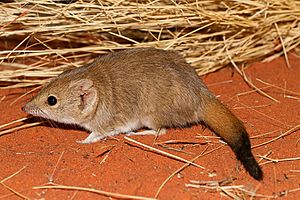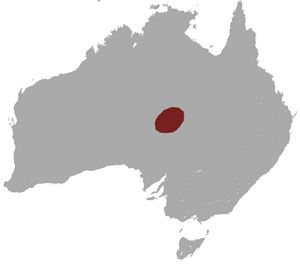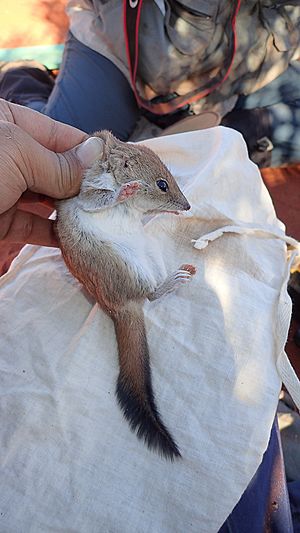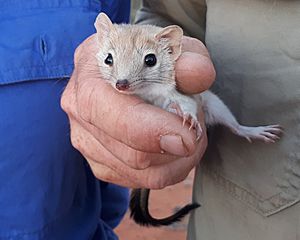Crest-tailed mulgara facts for kids
Quick facts for kids Crest-tailed mulgara |
|
|---|---|
 |
|
| Crest-tailed mulgara, Simpson Desert | |
| Conservation status | |
| Scientific classification | |
| Genus: |
Dasycercus
|
| Species: |
cristicauda
|
 |
|
| Crest-tailed mulgara range | |
The crest-tailed mulgara (Dasycercus cristicauda) is a small Australian marsupial. It's a meat-eating animal, part of a family called Dasyuridae. This family includes other cool animals like quolls and the Tasmanian devil. Mulgaras are native predators that live in Australia's dry, desert areas.
Contents
What Does a Mulgara Look Like?
The crest-tailed mulgara has sandy-colored fur on its back. Its belly and inner legs are a darker gray. Males are usually bigger than females. Adult males weigh between 100 and 185 grams. Females are smaller, weighing 65 to 120 grams.
Their body length is about 12.5 to 23 centimeters. Their tail adds another 7.5 to 12.5 centimeters. It can be tricky to tell the crest-tailed mulgara apart from its close relative, the brush-tailed mulgara.
How to Tell Them Apart
The tail is the best way to identify them. The crest-tailed mulgara has a special crest of fine black hairs. These hairs run along the top edge of its tail, looking a bit like a fin. The hairs get shorter towards the tip of the tail.
The brush-tailed mulgara's tail is different. It doesn't have this crest. Its black hairs start halfway along the tail. The hair length stays the same all the way to the tip.
Another way to tell them apart is by counting nipples. Female crest-tailed mulgaras have eight nipples. Female brush-tailed mulgaras only have six.
Where Do Mulgaras Live?
The crest-tailed mulgara lives in the dry, desert parts of Australia. They have been seen in the southern Simpson Desert. They also live in the Tirari and Strzelecki Deserts in South Australia. You can also find them in the western Lake Eyre area.
Long ago, these mulgaras lived in many more places. Their range included areas like Ooldea and the Musgrave Ranges. They were also found in Queensland and Western Australia. It's hard to know exactly how much their home range has changed. This is because it was sometimes difficult to identify them correctly in the past.
Mulgara Homes and Food
Mulgara Homes
Crest-tailed mulgaras like to live on sand ridges. They also live around salt lakes in inland Australia. During the day, they hide in burrows. These burrows are often found at the base of certain plants. They like to dig under clumps of sandhill canegrass or Nitre bush. These plants grow around the edges of salt lakes.
Where they live depends on good burrow spots. It also depends on rainfall and how much food is available. The age of the plants in the area after a fire can also affect where they choose to live.
What Do Mulgaras Eat?
The crest-tailed mulgara is a flexible eater. It's not picky about its food. It eats many different things. Its diet includes insects, arachnids (like spiders), and small rodents. They also eat reptiles, centipedes, and other small marsupials. They look for food along the tops and sides of sand dunes. Sometimes they go down into the flat areas between the dunes.
Mulgara Life Cycle
Crest-tailed mulgaras can start having babies when they are one year old. They usually have their young between winter and early summer. A mother mulgara can have up to eight babies in one litter. The young mulgaras become independent in spring and early summer.
Protecting the Mulgara
The crest-tailed mulgara is a species that needs protection. It is listed as "Vulnerable" by the Australian government. This means it could become endangered if we don't protect it. For over 100 years, people thought the mulgara was gone from New South Wales. But in 2017, it was found again in Sturt National Park!
Official Protection Status
- Australia: Listed as Vulnerable under the EPBC Act 1999.
- Worldwide: Listed as Near Threatened by the IUCN Red List.
- Western Australia: Listed as P4 (Priority Fauna).
- New South Wales: Listed as Extinct (Biodiversity Conservation Act 2016), as of April 2018. (This listing was before its rediscovery in 2017 was fully updated in the official records).
- Northern Territory: Listed as Vulnerable (Territory Parks and Wildlife Conservation Act 2000), as of 2012.
- Queensland: Listed as Vulnerable (Nature Conservation Act 1992), as of September 2017.
- South Australia: Listed as Endangered (National Parks and Wildlife Act 1972), as of June 2011.
Dangers to Mulgaras
Several things threaten the crest-tailed mulgara. They are hunted by introduced animals like the European red fox and feral cats. Changes in how often fires happen also affect their homes. Their habitat is also harmed by grazing animals. Livestock and introduced European rabbits eat the plants they need.
Interestingly, when a disease reduced the number of rabbits, the mulgara population grew a lot. This shows that too many rabbits were a big problem for them.
See also
 In Spanish: Mulgara para niños
In Spanish: Mulgara para niños




